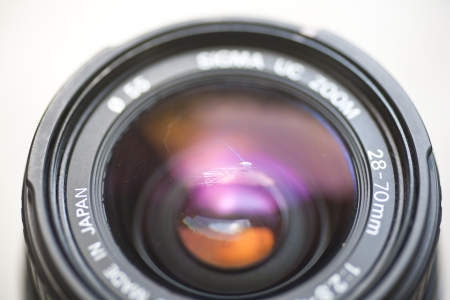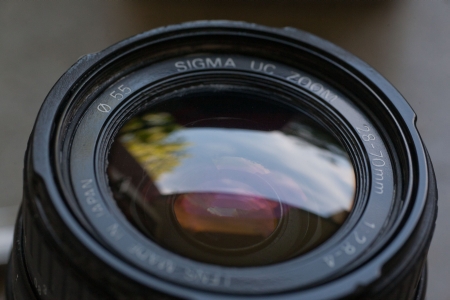How scratched lenses could be reparied with polishing
Scratches in lenses seem to be a big problem for some photographers - but normaly a short scratch will not be visible in the image. The scattered light from the scratch might be measured as a somewhat smaller contrast. But in some cases it may be a problem.
Owner of new lenses most likely try to exchange the scratched lens element with a new one.
But for older lenses in most cases no replacment parts are available. Some have probably heard about lens polishing to remove scratches.
Lens polishing could also helf to remove fungus damage.
Is this possible, how can this be done?
I have done some earlier experiments, but they failed. Let's talk about the way that worked well:
Here is the modern lens with scratches on the front lens. The lens is hard-coated. The anti reflection coating is very strong, and it is not easy to get such scratches!
Even with metal its not easy. Sand could do this very fast beacuse it is very hard!

For the first test of this method I used the lens complete without disassembly. This is NOT the correct way of working. Especially for AF and zoom constructions the mechanical force applied
this way could damage the lens! Furthermore the polishing fluid could get into the lens.
You need to disassemble the front lens!
I worked with an affixed drill and a sisal polishing wheel (for metal). The drill is fixed, and on high revolution speed.
As polishing
abrasive I used Nigrin glass polish, made for car windows. In the picture I used way too much of it.
It seems the exact description is not polishing but buffing.
Here you can see the cleaned lens: I could no longer photograph the scratch - but a much smaller of one of the scratches is still there.
This lens has no longer an antireflection coating on the front lens - this results in ~4% less transmission for
perpendicular light rays, for oblique rays even less transmission.
This light loss is not much, and an uncoated front lens is no cause for further reflections in the image - as long as one works without a front filter!
So, are there other problems with polishing the lens?
Yes!
During production, normal camera lenses obtain a very accurate curvature, let's say a surface accuracy of about 130nm.
But scratches are normaly much deeper!
Here some numbers from a 3M paper: Deep scratches that could be easily felt with the finger nail are deeper than 20µm, those scratches that could nearly not be felt are between 5 and 20µm deep. Scratches than can only be seen, but not felt are smaller than 5µm deep. And mat looking surfaces have probably less than 2µm depth. All much deeper than the estimated surface quality of a lens.
With this lens surface
polishing we remove the lens antireflection coating. On newer lenses, this AR coating is pretty hard. I think sometimes the glass itself might be softer - which results in a very high risk to change the lens surface shape. It is most likely that your spherical lens is aspherical after polishing - but not in the correct way to reduce spherical abberation :-)
Lens polishing during lens production is made with very exact bowls.
This tinkering could destroy your lens, and the machine drill or polishing machine could harm your health!
Please be careful!
And avoid polishing radioactive lenses - the fine radioactive dust would be very bad in your lung!
Please visit my other photo Do It Yourself work, or my photo repair and modification directory with ~1700 DIY links to other photo tinkering sites.

